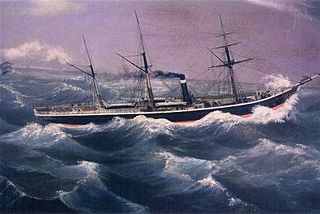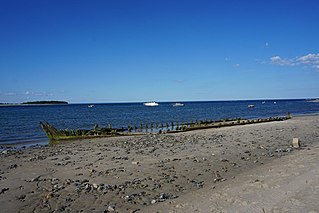Related Research Articles

Hereward, was British clipper ship that was built in Scotland in 1877. She had an iron hull, three masts and full rig.

SS Republic was a sidewheel steamship, originally named SS Tennessee, lost in a hurricane off the coast of Georgia in October 1865, en route to New Orleans.
Graveyard of the Atlantic is a nickname for the treacherous waters and area of numerous shipwrecks off the Outer Banks of North Carolina, United States, which are due to the coast's shifting sands and inlets. To a lesser degree, this nickname has also been applied to Sable Island off of Nova Scotia, Canada, as well as the waters off Cape Cod, Massachusetts, United States.
The Norwegian Lady Statues are located in the sister cities of Moss, a coastal town and municipality in the county of Østfold, Norway, and at the Oceanfront (boardwalk) in the coastal resort city of Virginia Beach, Virginia in the United States. They commemorate the lives lost in the 1891 shipwreck of the Norwegian barque Dictator off the coast of Virginia Beach and the lifesaving efforts of the community.

SS Admella was an Australian passenger steamship that was shipwrecked off the coast of the colony of South Australia in 1859. It broke up after striking a submerged reef near Cape Banks, off the coast near Carpenter Rocks, southwest of Mount Gambier, in the early hours on 6 August 1859. Survivors clung to the wreck for over a week and many people took days to die as they glimpsed the land from the sea and watched as one rescue attempt after another failed.

Neva was the British merchant ship Thames, launched in 1801, that the Russians bought in 1803, and renamed Neva. She participated in two trips to the Far East, the first of which was the first Russian circumnavigation of the world. She was wrecked in January 1813.
Blackpool and the Fylde coast have become a ship graveyard for a number of vessels over the years. Most of the shipwrecks occurred at or near Blackpool, whilst a few happened a little further afield but have strong connections with the Blackpool area. For this article, Blackpool means the stretch of coast from Fleetwood to Lytham St Annes.

Loch Vennachar was an iron-hulled, three-masted clipper ship that was built in Scotland in 1875 and lost with all hands off the coast of South Australia in 1905. She spent her entire career with the Glasgow Shipping Company, trading between Britain and Australia. The company was familiarly called the "Loch Line", as all of its ships were named after Scottish lochs. The ship was named after Loch Venachar, in what was then Perthshire.

Loch Sloy was a Scottish sailing barque that operated between Great Britain and Australia from the late 19th century until 1899. Her name was drawn from Loch Sloy, a freshwater loch which lies to the north of the Burgh of Helensburgh, in the region of Argyll and Bute, Scotland. Ships Captains: 1877 - 1885 James Horne, 1885 – 1890 John McLean, 1890 – 1895 Charles Lehman, 1895 – 1896 James R. George, 1896 – 1899 William J. Wade, 1899 Peter Nicol.
Phyllis was a British transport noted for having been wrecked near the Burin Peninsula on the south coast of Newfoundland, and for the subsequent survival under brutal conditions and rescue of many of her passengers and crew.
Aeolus was a wooden ketch built in 1850 at Pyrmont, New South Wales, Australia. She was carrying timber to Sydney, New South Wales, when she was lost at Hole in the Wall, Jervis Bay, New South Wales, on 24 October 1867. The wreck has not been located, but its approximate position is 35.134648°S 150.745874°E.

The Fitzroy was a steel-hulled steamship built in 1912 at Old Kilpatrick, Scotland in 1912. Thirty-one people were killed when Fitzroy capsized in a gale whilst carrying a general cargo between Coffs Harbour and Sydney off Cape Hawke, New South Wales on 26 June 1921.

The Centerville Beach Cross is a monument that commemorates the 17 passengers and 21 crew members who died in the shipwreck of the SS Northerner on January 6, 1860. The vessel, owned by the Pacific Mail Steamship Company, struck a rock near Cape Mendocino and wrecked near Centerville Beach, in Humboldt County, California. The monument is registered as California Historical Landmark # 173.
Bredenhof was a Dutch East Indiaman transport ship that foundered on a reef 120 miles (190 km) south of Mozambique and only 13 miles (21 km) off the African coast, near the Cape of Good Hope, on 6 June 1753. The loss of the Bredenhof on her third voyage to the East Indies was meticulously recorded in the Dutch archives.
Many ships have wrecked in and around San Francisco Bay. For centuries San Francisco Bay, with its strong currents, rocky reefs, and low fog conditions has experienced more than a hundred shipwrecks. Ever since San Francisco Bay was encountered during the land expedition of Gaspar de Portolà in 1769, it has been one of the most popular harbors.

Ada K. Damon was a Grand Banks schooner that was used for fishing and later for sand transportation. She was wrecked on 26 December 1909 during a large snowstorm when her anchor chain parted, setting her adrift. Today, the remains of the wreck are a local landmark, a tourist attraction, and an archeological site.
References
- 1 2 "The Faithful Steward Wreck & Delaware's Coin Beach". NovaNumismatics.com. Retrieved 2018-06-25.
- ↑ ""Faithful" Coins Wash Ashore From Delaware Shipwreck | National Underwater and Marine Agency". www.numa.net. Retrieved 2018-06-25.
- ↑ "2008 Museum Website for DiscoverSea Shipwreck Museum - Faithful Steward". www.discoversea.com. Retrieved 2018-06-25.